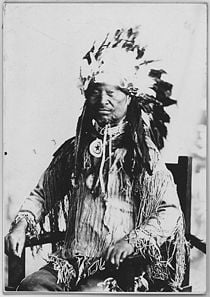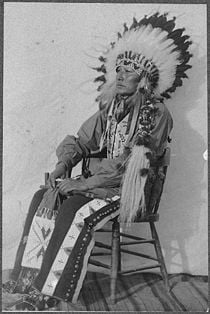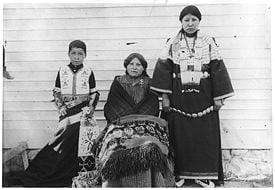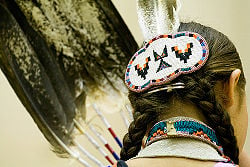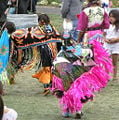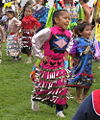Potawatomi
| Potawatomi |
|---|
| Total population |
| 28,000 |
| Regions with significant populations |
| United States (Oklahoma, Kansas, Nebraska, Wisconsin, Michigan, Indiana) |
| Languages |
| English, Potawatomi (an Algonquian language) |
| Religions |
| Christianity, Drum Religion, Native American Church |
| Related ethnic groups |
| Ojibwe, Ottawa, and other Algonquian peoples |
The Potawatomi (also spelled Pottawatomie or Pottawatomi) are a Native American people originally of the Great Lakes region. They traditionally speak the Potawatomi language, a member of the Algonquian family.
The Potawatomi controlled a vast amount of territory in the 1700s and served as middlemen for the fur trade between the French and various Great Lakes Tribes. Among the first Native Americans to intermarry with the Europeans, they fought alongside the French in the French and Indian Wars and later as allies of the British in the War of 1812.
Descendants numbered approximately 30,000 in the early twenty-first century, scattered throughout Canada and the United States, with many settled on or near the ten (official and unofficial) reservations. Most of today's Potawatomi also claim European descendancy.
Etymology
Potawatomi, meaning "Keepers of the fire" or "People of the place of the fire" is believed to be an old Chippewa (or Ojibwe) term—"potawatomink"—applied to the group for their role in the tribal council. The Potawatomi and Chippewa, along with the Ottawa were an Algonquin group who once constituted a single tribe. The role the Potawatomi played was to retain the original council fire, hence the name.
Some scholars debate this origin, but it is generally accepted as fact by tribal members today.
History
Potawatomi oral history holds that the ancient Potawatomi were once part of a larger group that traveled down the Atlantic shores of North America, eventually making their way west to Georgian Bay on Lake Huron (Canada). While at Georgian Bay, the group, a single tribe, split into what became known as the individual Chippewa, Ottawa and Potawatomi tribes.
Early historic records confirm that the Potawatomi were living in present-day Michigan and had established an autonomous tribe as early as the 1500s. The first recorded contact between Europeans and the Potawatomi was in 1634 by a French trader named Jean Nicolet at what is now called Red Bank, on the Door Peninsula, along the western shore of Lake Michigan. Living primarily in the northern third of lower Michigan, they began leaving their homeland in the mid-1600s in response to the Beaver Wars and headed north to Wisconsin.[1]
Seventeenth century
In the mid-seventeenth century the Iroquois sought to expand their territory and monopolize the fur trade and the trade between European markets and the tribes of the western Great Lakes region. A series of brutal conflicts erupted between the Iroquois Confederation, (largely Mohawk), and the largely Algonquian-speaking tribes of the Great Lakes region.
Known as the French and Iroquois Wars, or "Beaver Wars," they were of extreme brutality and are considered one of the bloodiest series of conflicts in the history of North America. The resultant enlargement of Iroquois territory realigned the tribal geography of North America, destroying several large tribal confederacies—including the Hurons, Neutrals, Eries, and Susquehannocks—and pushing other eastern tribes west of the Mississippi River.
Both Algonquian and Iroquoian societies were greatly disturbed by these wars. Attempting to avoid the battles, the Potawatomi moved northward into Wisconsin. The tribe adapted well, growing corn, gathering wild rice, and harvesting fish and waterfowl from the western waters of Lake Michigan.
Dependent upon the fur trade, the French welcomed delivery of pelts to their base in Montreal. When the Wyandot and Ottawa used Chippewa warriors to assist them in their journey, the Iroquois responded by going to the source, Wisconsin and upper Michigan, where they attacked any tribe supplying fur to the Algonquin middlemen. This forced more than 20,000 refugees into a space much too small to support them. They suffered epidemics and starvation and began fighting amongst themselves for hunting grounds.
The Potawatomi, however, were more fortunate, because their villages were located on the Door Peninsula jutting out into Lake Michigan, which had some of the best soil in the area. Protected thus from the fate befalling their neighboring tribes, they found it easier to maintain their tribal unity while larger tribes separated into mixed villages. This allowed them to become the dominant tribe in an area which also contained Wyandot, Ottawa, Illinois, Miami, Nipissing, Noquet, Menominee, Winnebago, Mascouten, Sauk Fox, Kickapoo and several bands of Ojibwe.
In 1687 the French and Algonquin began driving the Iroquois back to New York. As they retreated, the Potawatomi began moving south along Lake Michigan, reaching its southern tip by 1695. One band settled near the Jesuit mission on the St. Joseph River in southwest Michigan. Soon the French built Fort Pontchartrain at Detroit (1701) and groups of Potawatomi settled nearby. By 1716 most Potawatomi villages were scattered throughout the area from Milwaukee to Detroit. During the 1760s they expanded into northern Indiana and central Illinois.[1]
Soon the Potawatomi controlled over 5 million acres encompassing the present-day states of Wisconsin, Michigan, Illinois, Indiana, and a small portion of Ohio. Not content to simply trap furs for the Europeans, they became middlemen, hiring other tribespeople to collect and trap the furs which they then sold to the French.
Eighteenth century
By the 1700s, the Potawatomi were well known to the French on the Saint Lawrence River. They had adapted well to life near the water; traveling Lake Michigan and its tributaries via canoe, rather than over land by horse or foot. They crafted canoes from birch-bark and hollowed out logs. Fish and waterfowl were plentiful. Deer, bears, buffalo, and smaller game kept hunters busy. The women cultivated such crops as beans, squash, pumpkin, onions, and tobacco. Excess corn was traded to the French and the northern tribes.
Gradually their interaction with the French increased and it became evident in their clothing. Deerskin and buffalo clothing, porcupine quills and brightly colored beads were replaced with cotton shirts and leggings, bright colored dresses and shawls. Shoes replaced moccasins, while fur turbans replaced feather headdresses.
During the French and Indian War, the Potawatomi were French allies against the common English enemy. They referred to themselves then as "Onontio's faithful," citing their name for the governor of New France. They gave military support to the Siege of Fort George in New York, as well as the rout of General Edward Braddock in 1755 near modern–day Pittsburgh.
French-Potawatomi intermarriage became common during the eighteenth century, and French surnames began appearing; Eteeyan, Jessepe, LaClair, Levier, Peltier and Vieux, among others.
Nineteenth century
By 1800, tribal villages were displaced by white settlements and pushed farther and farther to the outskirts of the Potawatomi tribal estate. At the beginning of the century, Tecumseh, a Shawnee leader, and his brother—most commonly known as "The Prophet"—garnered the support of the Potawatomi, Kickapoo, Sauk, Fox, and Winnebago. Tecumseh was a brilliant chief, warrior, orator and leader not only of his own Shawnee Tribe but others who felt the need to stand up to the newly formed American nation.
By this time, the Potawatomi had joined forces with the British, their former enemy. Tecumseh and a group of warriors, including Potawatomi, played a key role in the War of 1812. Tecumseh joined British Major-General Sir Isaac Brock to force the surrender of Detroit in August 1812, a major victory for the British. Tecumseh, who directed most of the fighting at the Battle of the Thames near Chatham in October 1813, was killed in the skirmish. As in the Revolution and the Northwest Indian War, after the War of 1812 the British abandoned their Indian allies to the Americans. This proved to be a major turning point in the Indian Wars, marking the last time that Native Americans would turn to a foreign power for assistance against the United States.
Generally considered a stalemate between Great Britain and the United States, the War of 1812 was a defeat for the Great Lakes tribes. Their leader, Tecumseh, was dead, and there was no longer foreign support. They were powerless to stop the American encroachment. Agencies and forts were built and treaties drafted. The initial treaties signed by the Potawatomi following the war made peace and forgave past grievances. However, before long, the treaties' purposes were for the ceding of land and eventual removal to reservations. In all, the Potawatomi signed 44 treaties in 78 years. [2]
Forced relocation, or "removal"
The rapidly increasing population of the United States following its independence from Britain necessitated a need for land. The solution was "Indian Removal"—a nineteenth century policy of the U.S. government that sought to relocate American Indian tribes living east of the Mississippi River to lands west of the river. In 1823 the Supreme Court handed down a decision stating that American Indians could occupy lands within the United States, but could not hold title to those lands because their "right of occupancy" was subordinate to the United States' "right of discovery." [3] The process was further accelerated with the passage of the Indian Removal Act of 1830, which provided funds for President Andrew Jackson to conduct land-exchange ("removal") treaties.
In legal terms, the Removal Act did not order the forced removal of any Native Americans. In practice, however, the Jackson administration put great pressure on tribal leaders to sign removal treaties. This pressure created bitter divisions within American Indian nations, as different tribal leaders advocated different responses to the question of removal. Often, U.S. government officials ignored tribal leaders who resisted signing removal treaties and dealt with those who favored removal.
What is quite well known is the atrocity the southern tribes endured on their forced trek to "Indian Territory"—modern day Oklahoma—which has come to be known as the Trail of Tears. In this, an estimated 4,000 Cherokee perished. Less well known is the Potawatomi's own journey.
During this period the Mission Band Potawatomi were forced to leave their homelands in the Wabash River Valley of Indiana. In September through November of 1838 they marched across four states, nearly 700 miles to land set aside for them in Kansas. Over 40 died along the way, half of them children. This became known as the Potawatomi Trail of Death. In the ten years following, approximately 600 more Potawatomi died at the St. Mary’s Sugar Creek Mission in Kansas, due in large part to the effects of the terrible march and rampages of disease on their weakened bodies.
During this time, all the various bands except the Pokagon were either relocated by the government or made their own choice to re-settle in order to avoid relocation. For a time the Mission and Prairie bands lived together on a small reservation in Kansas. However, their differences—the Prairie had adapted different lifestyles due to their years in Iowa with the Ottawa and Ojibwe and had vastly different ceremonial and subsistence strategies—eventually proved to be too much and they separated even within the small reservation acreage.
The Mission Band took U.S. citizenship, became known as the “Citizen Potawatomi,” and the majority of them moved to Indian Territory (Oklahoma) by the early 1870s.
Tribal Bands
As with most Native American tribes, the Potawatomi have several sub-nations, known as bands.
In the 1700s there were three groups of Potawatomi based on location:
- The Detroit Potawatomi of southeast Michigan
- The Prairie Potawatomi of northern Illinois
- The Saint Joseph Potawatomi of southwest Michigan
These divisions had changed by 1800 due to movement of the tribes, and evolved into:
- Potawatomi of the Woods of southern Michigan and northern Indiana
- Forest Potawatomi of northern Wisconsin and upper Michigan
- Potawatomi of the Prairie of northern Illinois and southern Wisconsin
By the end of the twentieth century, Potawatomi descendants had scattered throughout the United States and Canada. There are a number of reservations in several states. Many Potawatomi are registered tribal members whether or not they live on or near a reservation. Today there are several separate groups and active bands of Potawatomi.
Those in the United States:
- Citizen Potawatomi Nation: This is the largest Potawatomi group and is federally recognized. Most are descended from the Potawatomi of the Woods and the Mission Band, who made the long trek from Indiana to Kansas. Christian and acculturated, they more easily accepted citizenship than the more traditional Prairie Band, with whom they shared a reservation for a time. The Citizen and Prairie Bands split in 1870 when the majority of Citizens moved to Oklahoma. They are headquartered in Shawnee, Oklahoma.
- Prairie Band Potawatomi Nation: Headquartered in Mayetta, Kansas, the Prairie Band left the Lake Michigan area for southwest Iowa in 1834. In 1846 they were removed to the Mission Band's Kansas reservation, where they remained when the Mission (Citizen Band) left for Oklahoma in 1870. Federal recognition has been maintained despite efforts to terminate them in 1953. They tend to be traditional and practice the Drum Religion alongside Catholicism or belong to the Native American Church.
- Nottawaseppi Huron Band of Potawatomi: Originally part of the Detroit tribes, the Nottawaseppi were gathered by soldiers and sent to Kansas in 1840. However, they escaped and returned to Michigan. In 1845, President Polk accepted their residence there and allotted them 40 acres of land (which increased by 80 acres 8 years later due to plans for a Methodist mission, which was established the following year). By the late 1880s, most of this band had accepted U.S. citizenship. Their federal recognition was terminated in 1902. In 1995 they were successful in regaining federal recognition after nearly a century of perseverance towards this goal. They are based in Calhoun County, Michigan.
- Forest County Potawatomi Community: This is possibly the most traditional group, having retained much of their original language, religion, and culture. They are descended from three Potawatomi bands from Lake Geneva in southern Wisconsin who avoided removal by moving north to the Black River and Wisconsin Rapids. In 1867 they were joined by Potawatomi who had left Kansas. They are federally recognized, with 99 percent of their land tribally owned. Tribal headquarters are in Crandon, in northern Wisconsin.
- Hannahville Indian Community: Similar to the Forest County Potawatomi, the Hannahville of Illinois refused forced resettlement. Some moved to northern Wisconsin and lived with the Menominee, while some went into Canada with the Ojibwe and Ottawa. Returning to the U.S., they were landless until an Ojibwe missionary, Peter Marksnian, procured land in upper Michigan for them in 1883. The area was named for his wife Hannah. The band soon came to be known as the Hannahville Potawatomi, was acknowledged by congress in 1913, and became federally recognized in 1936.
- Pokagon Band of Potawatomi Indians: The Pokagon were protected from removal by treaty, due in large part to their acculturation and conversion to Catholicism. They remained in southwest Michigan in the area of the St. Joseph Mission. They were denied tribal status under the Indian Reorganization Act of 1934. Absent a reservation, they are headquartered in Dowagiac, Michigan, from where they serve tribal members scattered throughout southern Michigan and northern Indiana. Tribal Recognition was restored and signed into law by President Clinton in September of 1994.
- Match-E-Be-Nash-She-Wish Band of Pottawatomi: In the 1700s this band was settled along the Grand River in Michigan. Following a series of treaties in the 1800s the Match-E-Be-Nash-She-Wish (named after a famed chief) was administratively attached to the Grand River Ottawa Band (or Grand Traverse Band of Ottawa and Chippewa) and not treated as a separate band of Potawatomi. By the early 1980s, members of the Match-E-Be-Nash-She-Wish Band began to consider requesting federal acknowledgment, finally filing a petition in 1993. Federal acknowledgment was awarded in 1999. They are based in Dorr, Michigan. [1]
During the 1830 removal to Kansas and Iowa, several bands of Potawatomi escaped to Canada. While some returned (Hannahville), others stayed and remain there today. These are:
- Moose Deer Point First Nation: The Moose Deer Point settled in southern Ontario, Canada in the late 1830s, during the time of U.S. government resettlement proceedings. They eventually joined the Beausoleil Band of Beausoleil Island in Lake Huron's Georgian Bay, near present day Port Severn, Ontario. Some members of both bands later moved north and established a settlement at Moose Point. The Moose Point reserve was first surveyed in 1917 and vested by an Order-in-Council the same year.
- Kettle and Stoney Point First Nation: This group is located in southern Ontario along the shores of Lake Huron, (35 kilometers from the town of Sarnia) near the Michigan border. It is a small group and is generally considered Chippewa. The Potawatomi who settled with this group of Ojibwe in the 1830s either moved on, or assimilated through marriage.
- Walpole Island First Nation: The Potawatomi settled permanently at Walpole Island only after 1836, joining the Ojibwe and Ottawa. Having a common heritage they formed the Three Fires Confederacy, a political and cultural compact. Walpole Island is un-ceded territory on the border between Ontario and Michigan in the mouth of the St. Clair River. Though referred to as a "reserve," Walpole Island has never been officially founded, legislated, established, set apart or surveyed as a "reserve." The First Nation band residing there still support their families through the traditional activities of hunting, fishing, trapping and guiding. According to one tradition, Tecumseh's grave is located there (though in fact the whereabouts of his remains have been a mystery since his death in 1813).
Culture
Forced assimilation
"Americanization" has been an unofficial policy of the U.S. government, based upon a belief that there is a standard set of cultural values that should be held in common by all citizens. These opinions were harshly applied when it came to Americanization of Native Americans compared to other immigrant populations who arrived with their "non-American traditions." It was believed that when indigenous people learned American customs and values they would soon merge tribal traditions with European-American culture and peacefully melt into the greater society.
The Dawes Act of 1887, which allotted tribal lands to individuals and resulted in an estimated total of 93 million acres (6,100 km²) leaving Native American lands, as well as the Indian Citizenship Act of 1924 were also part of these policies.
In the 1800s and early 1900s, traditional religious ceremonies were outlawed and it was mandatory for children to attend English-speaking boarding schools where native languages and cultural traditions were forbidden. Education was and is viewed as the primary method in the acculturation process.
Indian boarding schools were established during the late nineteenth and early twentieth centuries to educate Native youth according to Euro-American standards. These schools were primarily run by missionaries. It has been documented that they were traumatic to many of the children who attended them, as they were punished if caught speaking their native languages, forced to practice Christianity instead of their native religions, had their hair sheared, their traditional clothing destroyed and customs banned, and in numerous other ways forced to abandon their Indian identity and adopt European-American culture. There are also documented cases of sexual, physical and mental abuses occurring at these schools. Widespread abuse in the boarding schools had a long-term effect on the Native American, without regard to tribal affiliation. Alcoholism and suicide became rampant.
There has been a large movement to establish healing services for survivors, many of whom are parents and grandparents. Willetta Dolphus, director of the South Dakota Coalition Against Sexual and Domestic Violence, says, “When the elders who were abused in these schools have the chance to heal, then the younger generation will begin to heal too.” [4]
Recovery
An event on the Pine Ridge Reservation in Wounded Knee, South Dakota in 1973 was important in the role it played in changing the common Native American mentality of the mid-twentieth century, which for the most part was one of defeat and resignation. The American Indian Movement, along with the Oglala Sioux, occupied the town and held it for 71 days while the U.S. Marshals Service laid siege.
Covered almost daily by the national news, it shed light on the Indian situation. It also instilled a sense of new-found pride in those who had previously felt a sense of shame at their heritage, when they realized that they were not alone and that it was alright to stand up and speak out. Language, culture, Native Religions and the old traditions began to revive.
Every band of the Potawatomi has been successfully reviving their language (an Algonquian tongue) and cultural traditions. Many of them have established language programs. Pow wows, a celebration of native song, dance, food, clothing and culture, are popular. Usually lasting at least three days, they are held annually and sometimes inter-tribally.
Potawatomi character
The Potawatomi have long been known for their entrepreneurial skills as well as foresight in relationships. They became master middlemen during the days of the fur-trade, and switched their allegiances when necessary as the French and English gained and lost dominance. Though they did not receive full value for the lands they ceded, they were often able to secure more favorable terms than other tribes.
They continue to use those skills today, setting up tax-free businesses on their reservations, bringing large revenue from both native and non-native customers. They've not only established casinos on their lands, but hire the best advisors and lawyers to guide and represent them.
The Potawatomi was one of the earliest tribes to intermarry, first with the French and then with the English. Many have also intermarried with Chippewa, Ottawa, Kickapoo and other Native peoples.
Many practice Native Religions, while the Christian (mainly Catholic) faith has many Native traditions and beliefs blended into it.
There are an estimated 30,000 - 40,000 who claim Potawatomi descendancy according to Tribal Roles.
Powwow Photo Gallery
Notes
- ↑ 1.0 1.1 1.2 Lee Sultzman, Potawatami History Retrieved October 25, 2018.
- ↑ Kansas Heritage Group - Potawatomi Web. Treaties between the Potawatomi and the United States of America, 1789 - 1867 Retrieved October 25, 2018.
- ↑ PBS.org.-Teachers Resource guide. Indian removal 1814 - 1858. Retrieved October 25, 2018.
- ↑ Andrea Smith, Soul Wound: The Legacy of Native American Schools Manataka American Indian Council. Retrieved October 25, 2018.
ReferencesISBN links support NWE through referral fees
- Clifton, James A., and Frank W. Porter. The Potawatomi. New York: Chelsea House Publishers, 1987. ISBN 978-1555467258
- Edmunds, David. "Two Case Histories; The Potawatomis." The Wilson Quarterly, New Year's 1986, 139-142.
- Edmunds, R. David. The Potawatomis, keepers of the fire. The Civilization of the American Indian series, v. 145. Norman, OK: University of Oklahoma Press, 1978. ISBN 978-0806114781
- Landes, Ruth. The Prairie Potawatomi; tradition and ritual in the twentieth century. Madison, WI: University of Wisconsin Press, 1970. ISBN 978-0299052904
- Mayrl, Damon. The Potawatomi of Wisconsin. The library of Native Americans. New York: PowerKids Press, 2003. ISBN 978-0823964284
- Sanna, Ellyn. Potawatomi, North American Indians today. Philadelphia, PA: Mason Crest Publishers, 2004. ISBN 978-1590846759
- Satz, Ronald N. American Indian Policy in the Jacksonian Era, Originally published Lincoln, Nebraska: University of Nebraska Press, 1975. Republished Norman, OK: University of Oklahoma Press, 2002. ISBN 0806143321
- Thornton, Russell. American Indian Holocaust and Survival: A Population History Since 1492. Norman, OK: University of Oklahoma Press, 1987. ISBN 0806120746
External links
All links retrieved November 30, 2022.
- Citizen Potawatomi Nation.
- First Nations. December 18, 1998. Potawatomi History.
- Kansas Heritage. Treaties with the Potawatomi.
Credits
New World Encyclopedia writers and editors rewrote and completed the Wikipedia article in accordance with New World Encyclopedia standards. This article abides by terms of the Creative Commons CC-by-sa 3.0 License (CC-by-sa), which may be used and disseminated with proper attribution. Credit is due under the terms of this license that can reference both the New World Encyclopedia contributors and the selfless volunteer contributors of the Wikimedia Foundation. To cite this article click here for a list of acceptable citing formats.The history of earlier contributions by wikipedians is accessible to researchers here:
- Potawatomi history
- French_and_Iroquois_Wars history
- Indian_Removal history
- Walpole_Island history
- Americanization_of_Native_Americans history
The history of this article since it was imported to New World Encyclopedia:
Note: Some restrictions may apply to use of individual images which are separately licensed.



